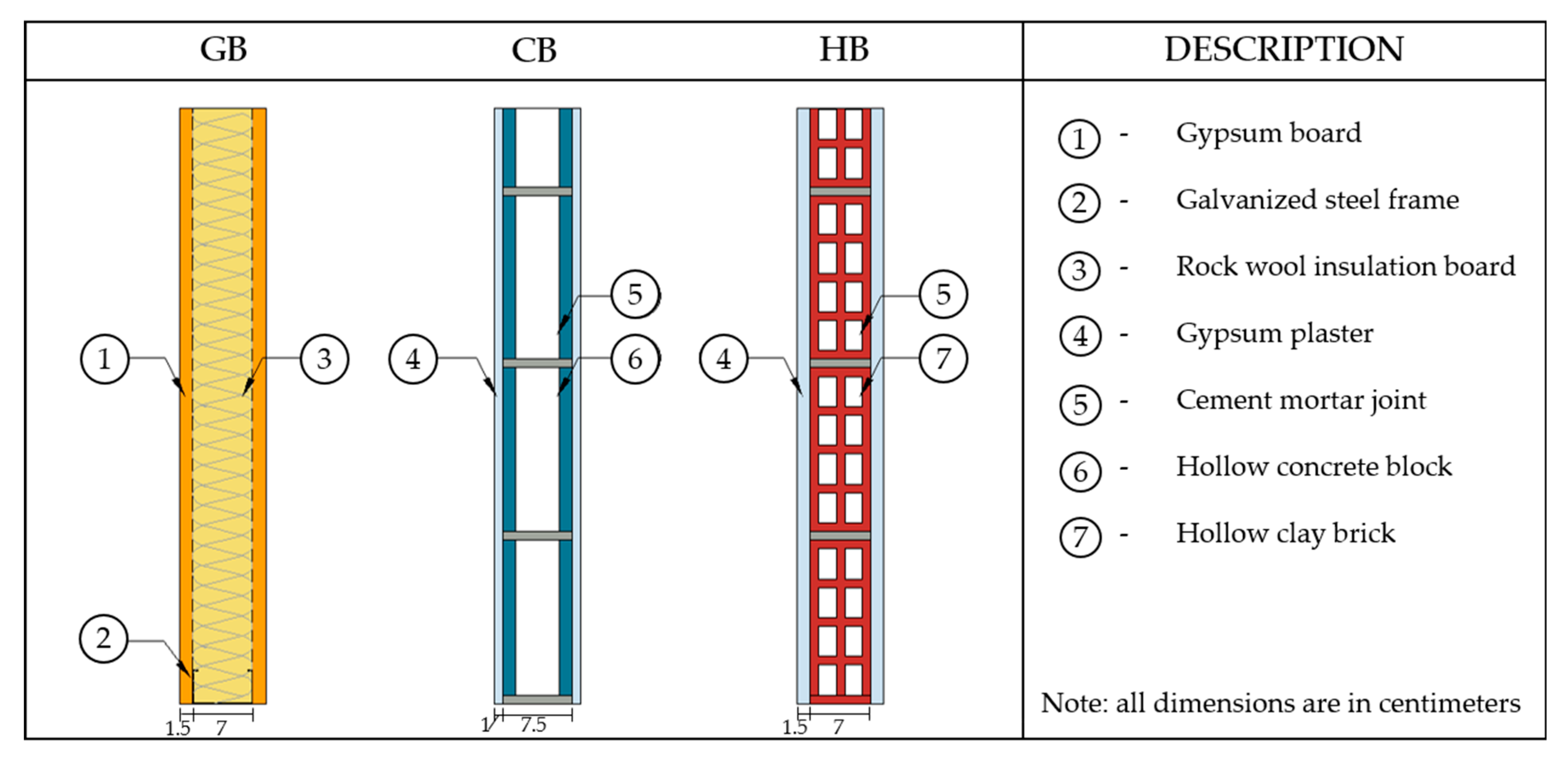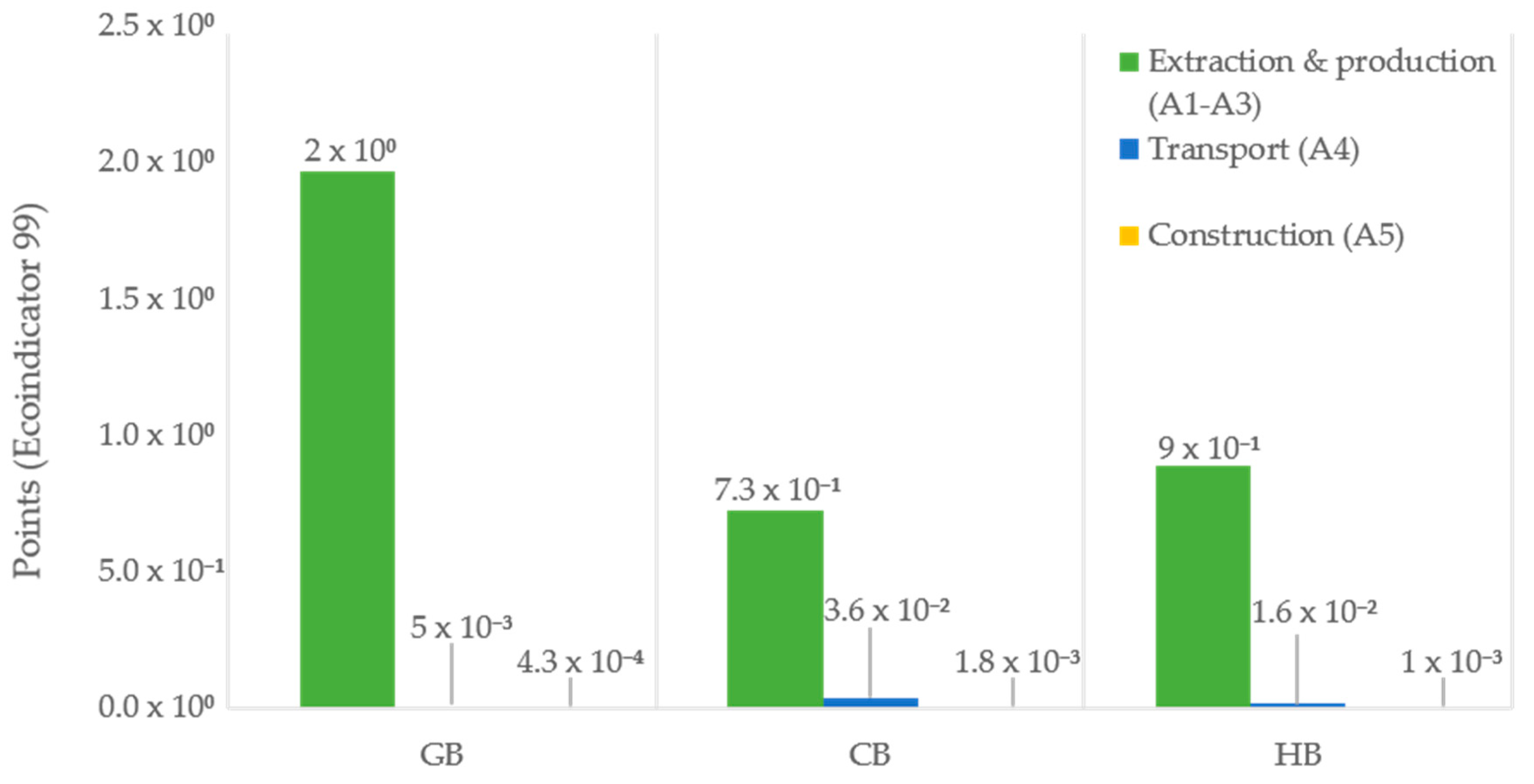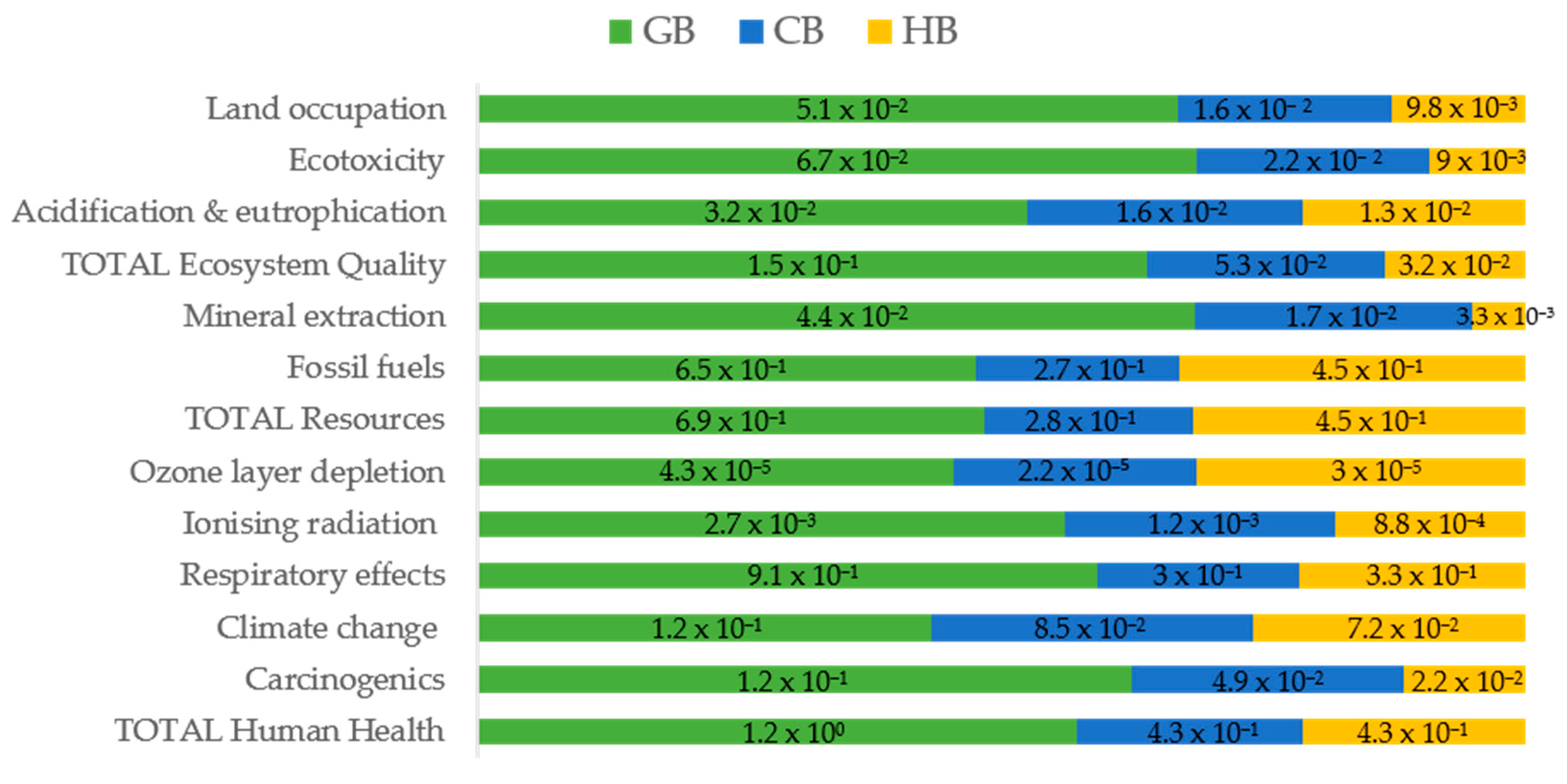LCA Analysis of Three Types of Interior Partition Walls Used in Buildings †
Abstract
1. Introduction
2. Materials and Methods
- Gypsum plasterboard wall (GB): drywall consisting on a galvanized cold formed Steel frame, with a ceiling channel of 7 × 3 × 3 cm and vertical studs of 6.9 × 3.8 × 3.6 cm every 60 cm; with a gypsum plasterboard of 1.5 cm at both sides, the inner field with an insulation of a rigid panel of volcanic Rockwool of 7 cm and joined by steel screws.
- Concrete block wall (CB): hollow concrete block of 40 × 20 × 8 cm, received with cement mortar (cement and sand ratio 1:8) and coated with 1 cm of gypsum plaster in both sides.
- Hollow clay brick wall (HB): hollow clay brick block of 50 × 20 × 7 cm, received with cement mortar (cement and sand ratio 1:8) and coated with 1.5 cm of gypsum plaster in both sides.
3. Results
- Land occupation: GB has three times more points than CB and five more than HB.
- Ecotoxicity: GB has three times more points than CB, and seven times more than HB.
- Acidification and eutrophication: GB has twice points than CB and HB.
- Mineral extraction: GB has 0.04 more points than HB, and 0.02 more points than CB.
- Fossil fuels: GB has 0.20 points more than HB and 0.38 more than CB.
- Respiratory effects: GB has 2.73 times more points than HB and 3 times more than CB.
- Climate change: GB has 0.04 points more than HB and 0.03 more than CB.
- Carcinogenic: GB has 0.09 more points than HB and 0.068 more than CB.
- Ozone layer depletion and Ionizing radiation are the indicators than generate the less impacts.
4. Discussion and Conclusions
Author Contributions
Acknowledgments
Conflicts of Interest
References
- Comisión Europea. Oportunidades para un uso más eficiente de los recursos en el sector de la construcción. In Estres en el Trabajo: Un reto Colectivo; OIT: Ginebra, Switzerland, 2014; 52014DC0445; ISBN 9789223306410. [Google Scholar]
- Scientific Applications International Corporation (SAIC). Life-Cycle Assessment: Principles and Practice; National Risk Management Research Laboratory, Office of Research and Development, US Environmental Protection Agency: Cincinnati, OH, USA, 2006; pp. 4–5. [Google Scholar]
- AENOR. AENOR: Norma UNE-EN 15804:2012+A1:2014. 2014. Available online: https://www.aenor.com/normas-y-libros/buscador-de-normas/UNE?c=N0052571 (accessed on 9 May 2018).
- Gestión Ambiental—Análisis del Ciclo de Vida—Requisitos y Directrices. ISO 14044. ISO 14044:2006(es). 2006. Available online: https://www.iso.org/obp/ui/#iso:std:iso:14044:ed-1:v1:es (accessed on 27 February 2018).
- Hallquist, A. Energy consumption: Manufacture of building materials and building construction. Habitat Int. 1978, 3, 551–557. [Google Scholar] [CrossRef]
- Sartori, I.; Hestnes, A.G. Energy use in the life cycle of conventional and low-energy buildings: A review article. Energy Build. 2007, 39, 249–257. [Google Scholar] [CrossRef]
- Citherlet, S.; Defaux, T. Energy and environmental comparison of three variants of a family house during its whole life span. Build. Environ. 2007, 42, 591–598. [Google Scholar] [CrossRef]
- Menoufi, K.; Castell, A.; Farid, M.M.; Boer, D.; Cabeza, L.F. Life Cycle Assessment of experimental cubicles including PCM manufactured from natural resources (esters): A theoretical study. Renew. Energy 2013, 51, 398–403. [Google Scholar] [CrossRef]
- Monteiro, H.; Freire, F. Life-cycle assessment of a house with alternative exterior walls: Comparison of three impact assessment methods. Energy Build. 2012, 47, 572–583. [Google Scholar] [CrossRef]
- Rincón, L.; Castell, A.; Pérez, G.; Solé, C.; Boer, D.; Luisa, F. Evaluation of the environmental impact of experimental buildings with different constructive solutions using Life Cycle Assessment and Material Flow Analysis. Appl. Energy 2013, 109, 544–552. [Google Scholar] [CrossRef]
- Rivela, B.; Cuerda, I.; Olivieri, F.; Bedoya, C.; Neila, J. Análisis de Ciclo de Vida para el ecodiseño del sistema Intemper TF de cubierta ecológica aljibe. Mater. Constr. 2013, 63, 131–145. [Google Scholar] [CrossRef]
- Saiz, S.; Kennedy, C.; Bass, B.; Pressnail, K. Comparative life cycle assessment of standard and green roofs. Environ. Sci. Technol. 2006, 40, 4312–4316. [Google Scholar] [CrossRef]
- Knoeri, C.; Sanyé-Mengual, E.; Althaus, H.J. Comparative LCA of recycled and conventional concrete for structural applications. Int. J. Life Cycle Assess. 2013, 18, 909–918. [Google Scholar] [CrossRef]
- Faleschini, F.; de Marzi, P.; Pellegrino, C. Recycled concrete containing EAF slag: Environmental assessment through LCA. Eur. J. Environ. Civ. Eng. 2014, 18, 1009–1024. [Google Scholar] [CrossRef]
- Turk, J.; Cotic, Z.; Mladenovic, A.; Sajna, A. Environmental evaluation of green concretes versus conventional concrete by means of LCA. Waste Manag. 2015, 45, 194–205. [Google Scholar] [CrossRef]
- Marinković, S.; Radonjanin, V.; Malešev, M.; Ignjatović, I. Comparative environmental assessment of natural and recycled aggregate concrete. Waste Manag. 2010, 30, 2255–2264. [Google Scholar] [CrossRef]
- Fay, R.; Treloar, G.; Iyer-Raniga, U. Life-cycle energy analysis of buildings: A case study. Build. Res. Inf. 2000, 28, 31–41. [Google Scholar] [CrossRef]
- Buyle, M.; Braet, J.; Audenaert, A. Life cycle assessment in the construction sector: A review. Renew. Sustain. Energy Rev. 2013, 26, 379–388. [Google Scholar] [CrossRef]
- Nebel, B.; Zimmer, B.; Wegener, G. Life cycle assessment of wood floor coverings: A representative study for the German flooring industry. Int. J. Life Cycle Assess. 2006, 11, 172–182. [Google Scholar] [CrossRef]
- Bowyer, J. Life Cycle Assessment of Flooring Materials: A Guide to Intelligent Selection; Dovetail Partners Inc.: Minneapolis, MN, USA, 2009; p. 10. [Google Scholar]
- Jönsson, Å.; Tillman, A.-M.; Svensson, T. Life cycle assessment of flooring materials: Case study. Build. Environ. 1997, 32, 245–255. [Google Scholar] [CrossRef]
- Nicoletti, G.M.; Notarnicola, B.; Tassielli, G. Comparative Life Cycle Assessment of flooring materials: Ceramic versus marble tiles. J. Clean. Prod. 2002, 10, 283–296. [Google Scholar] [CrossRef]
- Mateus, R.; Neiva, S.; Bragança, L.; Mendonça, P.; Macieira, M. Sustainability assessment of an innovative lightweight building technology for partition walls—Comparison with conventional technologies. Build. Environ. 2013, 67, 147–159. [Google Scholar] [CrossRef]
- Broun, R.; Menzies, G.F. Life cycle energy and environmental analysis of partition wall systems in the UK. Procedia Eng. 2011, 21, 864–873. [Google Scholar] [CrossRef]
- Instituto de Estadística de Cataluña. Idescat. Indicadores de la Unión Europea. Available online: https://www.idescat.cat/indicadors/?id=ue&lang=es (accessed on 11 June 2018).
- Ministerio de vivienda de España. Código Técnico de la Edificación; Real Decreto, 314. Marzo 2006. Madrid, Spain. 2006. Available online: https://www.codigotecnico.org/index.html.
- Ministerio de vivienda de España. CTE-Documento básico de Protección frente al ruido (DB-HR). 2007. Available online: https://www.codigotecnico.org/index.php/menu-proteccion-frente-ruido.html.
- E. Z. Swiss Federal Offices. Ecoinvent Database, V3.0. 2007. Available online: https://www.ecoinvent.org/database/database.html (accessed on 21 April 2018).
- Gámez-García, D.C.; Gómez-Soberón, J.M.; Corral-Higuera, R.; Almaral-Sánchez, J.L.; Gómez-Soberón, M.C.; Gómez-Soberón, L.A. LCA as comparative tool for concrete columns and glulam columns. J. Sustain. Archit. Civ. Eng. 2015, 11, 21–31. [Google Scholar] [CrossRef][Green Version]
- Ortiz, O.O.; Asqualino, J.P.; Castells, F. Evaluación ambiental basada en el análisis del ciclo de vida (ACV) en la fase de construcción de una edificación en Cataluña. Afinidad 2010, 67, 175–181. [Google Scholar]
- Ferrández-García, A.; Ibáñez-Forés, V.; Bovea, M.D. Eco-efficiency analysis of the life cycle of interior partition walls: A comparison of alternative solutions. J. Clean. Prod. 2016, 112, 649–665. [Google Scholar] [CrossRef]
- Instituto de Tecnología de la Construcción. Banco de Precios BEDEC ITeC; ITEC: Barcelona, Spain, 2017. [Google Scholar]
- Google. Google Earth. Available online: https://www.google.es/intl/es/earth/index.html (accessed on 21 May 2018).
- Ministerio de Fomento de España. Vehículo a Motor de 2 ejes-Pesos (Vehículos de Motor)-Pesos-Pesos y Dimensiones-Inspección y Seguridad en el Transporte-Transporte Terrestre-Áreas de Actividad-Ministerio de Fomento. Available online: https://www.fomento.gob.es (accessed on 4 June 2018).
- Administración Pública del Área Metropolitana de Barcelona. Secció 3a Zona de Densificació Urbana: Subzona I, Intensiva I Subzona II, Semiintensiva (13), Pub. L. No. 321–328, 173 (2004). Available online: www3.amb.cat/normaurb2004/Docs/Normes.htm (accessed on 17 May 2018).
- Simpple Efficient Solutions. 2010. Manual de usuario LCA Manager Versión 1.3. Tarragona, España: Simpple. Available online: https://www.simpple.com/es/productes/lcamanager/ (accessed on 7 April 2018).
- Pré Consultants., 2000. Eco-Indicator 99–Manual for Designers. In Ministry of Housing, Spatial Planning and the Environment; Available online: http://www.pre-sustainability.com/download/manuals/EI99_Manual.pdf (accessed on 19 April 2018).
- Bribián, I.Z.; Capilla, A.V.; Usón, A.A. Life cycle assessment of building materials: Comparative analysis of energy and environmental impacts and evaluation of the eco-efficiency improvement potential. Build. Environ. 2011, 46, 1133–1140. [Google Scholar] [CrossRef]
- Monahan, J.; Powell, J.C. An embodied carbon and energy analysis of modern methods of construction in housing: A case study using a LCA framework. Energy Build. 2011, 43, 179–188. [Google Scholar] [CrossRef]
- Koroneos, C.; Dompros, A. Environmental assessment of brick production in Greece. Build. Environ. 2007, 42, 2114–2123. [Google Scholar] [CrossRef]



Publisher’s Note: MDPI stays neutral with regard to jurisdictional claims in published maps and institutional affiliations. |
© 2019 by the authors. Licensee MDPI, Basel, Switzerland. This article is an open access article distributed under the terms and conditions of the Creative Commons Attribution (CC BY) license (https://creativecommons.org/licenses/by/4.0/).
Share and Cite
Valencia-Barba, Y.E.; Gómez-Soberón, J.M. LCA Analysis of Three Types of Interior Partition Walls Used in Buildings. Proceedings 2018, 2, 1595. https://doi.org/10.3390/proceedings2221595
Valencia-Barba YE, Gómez-Soberón JM. LCA Analysis of Three Types of Interior Partition Walls Used in Buildings. Proceedings. 2018; 2(22):1595. https://doi.org/10.3390/proceedings2221595
Chicago/Turabian StyleValencia-Barba, Yovanna E., and José M. Gómez-Soberón. 2018. "LCA Analysis of Three Types of Interior Partition Walls Used in Buildings" Proceedings 2, no. 22: 1595. https://doi.org/10.3390/proceedings2221595
APA StyleValencia-Barba, Y. E., & Gómez-Soberón, J. M. (2018). LCA Analysis of Three Types of Interior Partition Walls Used in Buildings. Proceedings, 2(22), 1595. https://doi.org/10.3390/proceedings2221595






